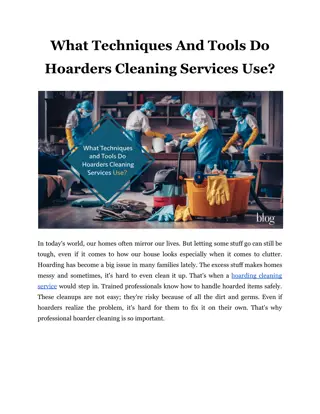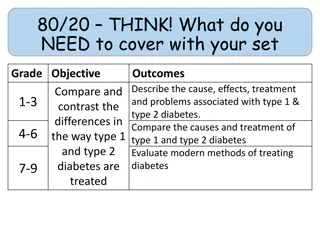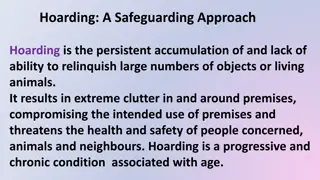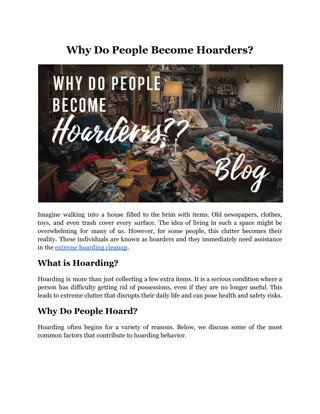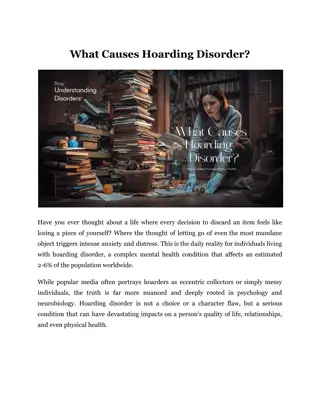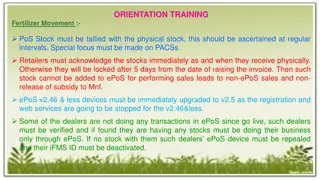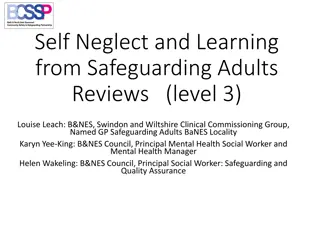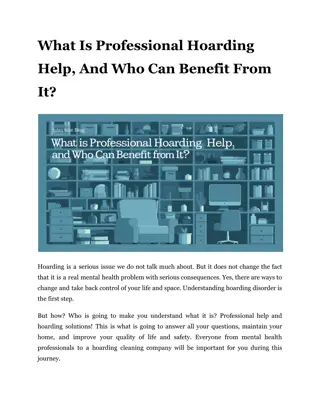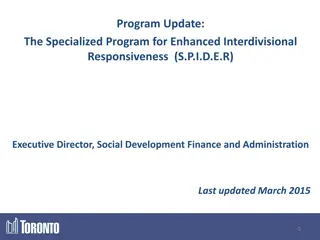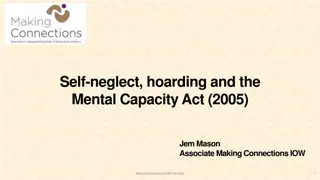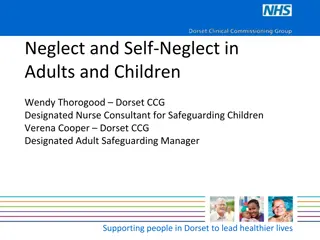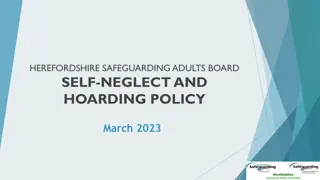Understanding Hoarding: Causes, Types, and Support
Hoarding disorder is a serious condition where individuals accumulate excessive items, leading to clutter and distress. Factors such as mental health issues, trauma, and family history can contribute to hoarding behaviors. Different types of hoarding, including inanimate objects, animal hoarding, and data hoarding, present unique challenges. Recognizing the signs, providing support, and promoting a family-centered approach are crucial in addressing hoarding effectively.
Download Presentation

Please find below an Image/Link to download the presentation.
The content on the website is provided AS IS for your information and personal use only. It may not be sold, licensed, or shared on other websites without obtaining consent from the author. Download presentation by click this link. If you encounter any issues during the download, it is possible that the publisher has removed the file from their server.
E N D
Presentation Transcript
Practice Week Introduction to LSAB Hoarding Pathway 24/04/2023
SAR findings and Hoarding Multi-agency guidance was created 2020 Later Identified: Guidance helpful but staff would like an easy user guide Staff would like a panel to refer to get support/guidance Think family approach needed Hoarding households needed support
Definition of Hoarding A hoarding disorder is where someone acquires an excessive number of items and stores them in a chaotic manner, usually resulting in unmanageable amounts of clutter. The items can be of little or no monetary value. 4 Hoarding is considered a significant problem if: the amount of clutter interferes with everyday living for example, the person is unable to use their kitchen or bathroom and cannot access rooms. the clutter is causing significant distress or is negatively affecting the quality of life of the person or their family for example, they become upset if someone tries to clear the clutter and their relationship suffers.
Why someone may hoard The reasons why someone begins hoarding are not fully understood. It can be a symptom of another condition. For example, someone with mobility problems may be physically unable to clear any amounts of clutter they have acquired, and people with learning disabilities or people developing dementia may be unable to categorise and dispose of items. Mental health problems associated with hoarding can include: severe depression psychotic disorders, such as schizophrenia obsessive compulsive disorder (OCD)
Hoarding disorder People affected by hoarding often are more likely to: Self-neglect or not engage with services or agencies Have suffered significant loss or trauma in the past Live alone be unmarried/single have had a deprived childhood, with either a lack of material objects or a poor relationship with other members of their family have a family history of hoarding have grown up in a cluttered home and never learned to prioritise and sort items
Types of Hoarding Inanimate objects: This is the most common. This could consist of one type of object or a collection of a mixture of objects such as clothing, newspapers, food, containers and papers, DVD s, CD s and books etc. Animal hoarding: This is the obsessive collecting of animals, often with an inability to provide minimal standards of care. The hoarder is unable to recognise that the animals are or may be at risk because they feel they are saving them. Data hoarding: Data hoarding is a newer type. There is little research on this matter, and it may not seem as significant as other types of hoarding, however people who do hoard data could still present with severe symptoms of hoarding.
Consent & Information sharing In principle consent should be obtained whenever possible in order to share information. Decisions about which information is shared and with who, needs to be taken on a case by-case basis. There is an expectation that each agency ensures compliance with the General Data Protection Regulations and Data Protection Act 2018 Information sharing may take place without consent where it is Necessary for the purpose for which it is being shared Justifiable and proportionate Accurate and up to date Shared in a timely fashion Shared securely
When does the local safeguarding adult s policy and procedures apply? The Care Act 2014, Section 42 requires for an enquiry to be initiated by the local authority when there is reasonable cause to suspect that an adult in its area (whether or not ordinarily resident there) (a) has needs for care and support (whether or not the authority is meeting any of those needs), (b) is experiencing, or is at risk of, abuse or neglect, and (c) as a result of those needs is unable to protect himself or herself against abuse or neglect or the risk of it.
What if Children are at risk? Whenever children are at risk of harm through hoarding, local authorities should be alerted using local safeguarding children policies and procedures. Where both children and adults are at risk a joined approach involving both children and adult services should be taken and involving other agencies (Fire and Rescue, Mediation etc.) as indicated. https://bedfordscb.proceduresonline.com/p_neglect.html https://bedfordscb.proceduresonline.com/files/hoarding_sab.pdf
What the scale indicate? Images 1-3 indicate Low risk self referral Images 4-6 indicate Medium risk Multi-agency meeting Images 7-9 indicate High risk Alert 24hrs and Multi-agency meeting
1-3 = Low Risk Offer advice, sign post to other agencies Arrange fire safety check with Bedfordshire Fire and Rescue Service Enlist person s supporters to help modify issue and prevent escalating Consider arranging an inter-agency meeting to follow up to prevent worsening
4-6 = Medium Risk and 7-9 = High Risk Convene multi-agency meeting- with action plan as the outcome Lead agency and roles of each party identified Ascertain via MASH which partners already involved Consider GP and mental health assessment Monitor and review Lead agency for the case checks progress and triggers further multi-agency meeting(s) if issues start up again or escalate
Clutter Scale 7-9 MASH will Screen and complete safeguarding planning meeting. MASH worker to complete initial Risk Management Plan. Consider Mental Capacity and complete MCA re- Hoarding, if relevant Inform Community Agencies e.g. Fire Service, Housing, Environmental Health, landlord, advocate etc. Recommendation for S42 and allocation to SW/SCA
Case Study Case discussion regarding Family O Rachel aged 9, Owen aged 12 and Polly aged 14 Please write down key points for your supervision session What advice would you like the supervisor to give you as the supervisee? As a supervisor what advice would you give What do you think the next steps should be?
I wanted to talk to you about a home visit I made on the new case I was allocated last week. As you can see from the genogram there are three children, a girl called Rachel aged 9, and two older children, Owen aged 12 and Polly aged 14 who have a different father and they have a shared care arrangement. Polly and her parents live in social housing, her mum seems to have a chronic illness, is a wheelchair user and a family member helps out. According to mum, Owen and Rachel are supposed to predominantly live with their father who lives a few miles away. Rachel is a child with a disability and attends special school.
Ive reviewed the case records and from the chronology it seems there have been four referrals in the past 12 months from the school, there was an early help assessment in June 2022 and a plan to provide support around parenting as mum was struggling with the older two children s behaviour, practical support with maintaining the house and the school s family worker was providing support with the older children s attendance at school. They also helped with school uniform, breakfast and after school club. Things seemed to be going well and Rachel and Polly attendance improved. Owen s attendance has never been a problem and he seems to want tobe at school and engaged well with the breakfast club and afterschool clubs.
Following this period of improvement there were further referrals with concerns regarding the home environment poor school attendance, and a lack of appropriate supervision as all three of the children were wandering around the estate after 11pm and their parents didn t seem concerned about not knowing their whereabouts and mum said there was just some confusion as to which parent they staying with. Mum was offered support through a single assessment as child in need but she initially declined consent.
This most recent referral there are similar concerns but in addition there has been a noticeable change in Owen s behaviour, he is constantly tired and talks about having to help out at home. Both he and Rachel seem to have a new group of older friends, which they do favours for . Mum has agreed for a single assessment to see what support the family can get, she also wants to talk about benefits for Rachel. When I visited the home was really chaotic with lots of boxes of old things, dirty litter trays, and old pet cage that has never been emptied, broken pushchairs etc, the walls are covered in writing from when they were small with ripped wallpaper and there are lots of flies in the home. There were lots of bags of washing but Rachel said it didn t matter as their mum s friend buys them lots of new stuff, they wash at their dads and some else brought them a PS5. There was no food in the fridge or freezer but Rachel said it was fine and she ordered 40 of take away on her phone (which also looked to be brand new). Owen also had on brand new trainers which mum said she wasn t sure where they had come from.
I didnt get a chance to really speak to mum as her family member said she was tired and needed to rest and she took her back to her room. Her family member declined to let me look in the children s bedrooms or in the bathroom. Rachel s dad wasn t present for the visit and hasn t answered my calls. Rachel s school says that he doesn t involve himself in Rachel s education. Secondary school advise that Owen and Polly s dad sometimes come to parents evening but he doesn t really support the school in their plans to help the children.
Adult Social Care worker Their home is really messy and dirty and extremely cluttered. They are storing bags of receipts from shopping and there are boxes of, I think their children s clothing from when they were babies/younger. The bathroom is really bad and it is full of mould and dirt. The toilet hasn t been cleaned for a really long time and the kitchen was filthy and cluttered. They usually just eat take-away food or ready meals. Sarah said her and Rob aren t really fussy eaters. Oh, and there was no running water- which Rob said he is trying to fix-they are using bottled water at present. Rebecca cares for Sarah during the day until about 8pm and then Rebecca lives her own personal life after that. Rob said that Rebecca has lots of male visitors to their home in the evenings. Sarah is lovely to talk to and told me about when her and Rob met and how great it was, he made her feel special and valued but then they started having as they difficulties with her parents and sister and so the couple stopped talking to them/seeing them. This is still the situation and she can t help feeling that Rob had created all the conflict with her family-but she can t remember really clearly.
Community Health said Not being able to move is impacting on Sarah, as she can t apply for a new council property. She needs one that is more suitable to meet her needs, as she is living with a long-term chronic health condition, which affects her mobility and function and her ability to care for herself. The previous time I saw her she could mobilise from her bedroom to the bathroom, but now, Sarah can t walk or stand for long periods of time. Rebecca is home with her all day. Sarah mobilises/transfers with her help, from her wheelchair onto her commode or to bed. She needs Rebecca. Rebecca carries out Sarah s personal care in bed, but only once a week, Sarah didn t want personal hygiene wore than this.. Oh-the bed linen looked dirty-not changed maybe? She lives in her bedroom and received support from the DN Service, for a urinary catheter and they still visit monthly for this and more recently has more frequent visits, as she has a sore on her leg, due to diabetes. The GP knows her and saw her in October and found her to be depressed-low mood, not eating very much and has made a MH referral. She still has no care package.
Housing said The property doesn t meet her needs as its too small and the required equipment (hoist etc.), can t be put in such small spaces. They have rent arrears so can t move. Sarah lives in council property with Rob got when they first got married (joint tenancy). At present, they either don t talk or argue terribly. Rob gets on with his own life, but won t move out (this is what Sarah wants), but he doesn t want to lose his accommodation, or rights, as her husband. Rob has an LPA for Sarah and keeps her bank card for her as he does the shopping for them. Sarah s bank account holds the back payment from her pay- out via PIP (personal independence payment) and ESA (employment support allowance). Oh, and one more thing-when I visited the home, the door was open. Rob said this is usually the case, as Rebecca received lots of packages, so it s a bother to open the door all the time.
Some supervision considerations What do we know about the children s individual parents their relationship status, how they met and the quality of the relationships. Who else can help us understand this? What do we know about mum s condition and how it impacts on her and her parenting, does she have capacity? Appropriateness of accommodation, is it a house of multiple occupancy, are there signs of overcrowding, what s happening with conditions in the home? Have you considered using GCP2 and the Hoarding Protocol? What do we know about the relative living with them and their activities in the home? What are the demands on the children in household tasks etc? What are your concerns about where the children are getting their money and the favours for older friends? Who have you spoken to about the children s health and in particular Rachel s disability do we know who s supporting her? What s happening for Owen around his behaviour being different at school? What can you do to engage the fathers of the children in making a plan?
Reflections? Questions?


